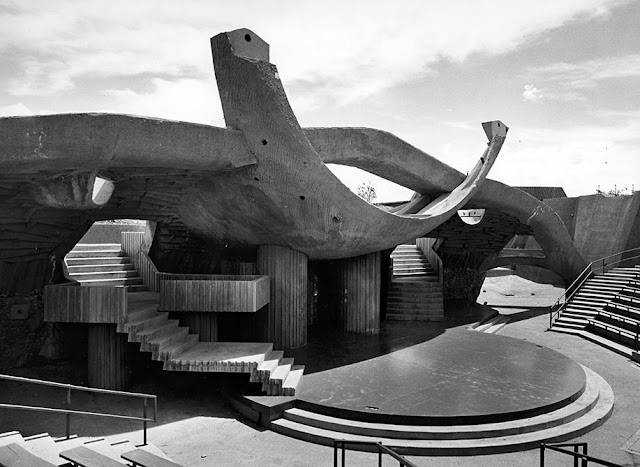Monuments of architecture and creators of the transcendence. Paolo Soleri (part 1)
(All images from the public domain)
Cities, despite their modular visualization, hold a fear, they exist in a unique space within time – by being defined as a structural construct, devised by its designers and occupants. But, the fear, is a resonance of what could be dead and alive as a simultaneous copy of itself. A city, expressed through its prefabrication, may have already reflected its own demise. Whether this will be brought on by economic collapse, environmental and population stresses, throughout history these structures that we sometimes admire, live in and take for granted, that in most cases are poorly designed and built, if left unkempt they falter, decay and eventually will be consumed back into nature. And this is important to understand within the context of what design is and good architecture means. The word suitability has be used before in describing the modern city, now a catch-cry of 21st Century sensibilities. In the 1960s, the fear of overpopulation on modern cities also enveloped into the beginning of the ecology movements – as a bases of the inability that a city can provide if it grows to quickly, becomes overpopulated and consumes resources beyond its capacity, that in turn effects the quality of life of its inhabitance. A real dilemma for city planners, more so the architect who will struggle to develop a future city that is of the now.
The late Paolo Soleri, an the Italian/American architect, had a vision of future cities, lessening the impact on the natural environment, he believed that a city should extended upwards, as a human and organic behemoth structure. A sustainable bio-sphere without cars or pollution. A reduced impact on the environmental. His concepts and ideas for urban planning are correct, the expansion and erosion of natural area puts a strain on the resources within a city, the urban sprawl is a flawed concept of city, yet skyscrapers, while they're built collectively as a way of dealing with high population growth, fail to contain the answer of sustainability and more importantly maintaining the quality of life a city. Soleri saw something grander, a Utopian concept of a city structure that rises up from the Earth from which it came. Yet, maintains its own presence as a living concept, the concrete, machinery and the human who resides within its vertical and communal frame work. He called this Archology.
However, Soleri, as a modern day architect, brought in a lot of the idealism that was earlier Utopian theory of the 1700 and 1800s, this can be seen by the French neoclassical architect Claude-Nicolas Ledoux with his works and ideas. Utopianism as a concept is a sound possibility to create a city that reflects life rather than a deadened presence – to which most cities have developed into, rather the structures created would assist in promoting the experimental concept of living whilst maintaining environments that enrich the well being of its occupants. We all, deep down search and long for a city and a society to be such a place. But, it is a dream. Utopia as a term is derived from Sir Thomas Moore's 1516 book Utopia, written about a fictional island society, conceived from the Greek words οὐ Meaning “not” and τόπος which inscribes a “place”. The idealistic concepts the early Utopians believed and stated of duch a place. Proponents like François Marie Charles Fourier (d1772) and others such as the English planner Ebenezer Howard (d1902) thought they could construct such a city, which doesn't exist as a reality, but if it did, it would be seen, in its development, as a better place than the contemporary society that we know of; it would be, by its definition a Utopian City. A blueprint of architectural ideology from over 200 years ago, to implement a drawn and scaled concept rather than the tangible, yet, they did create structures within a city under the Utopian guise. More importantly as did Soleri right up to his death in 2013, with his idea formed under his 1969 book Arcology: The City in the Image of Man (1969) And in 1970 he began constructing within the Arizona desert his Utopian dream of "The Arcosanti."










Comments
Post a Comment